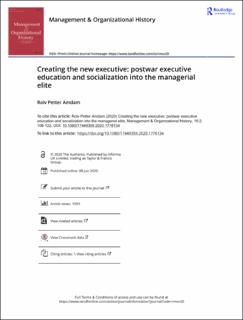| dc.contributor.author | Amdam, Rolv Petter Storvik | |
| dc.date.accessioned | 2021-07-12T10:38:46Z | |
| dc.date.available | 2021-07-12T10:38:46Z | |
| dc.date.created | 2020-06-10T11:15:05Z | |
| dc.date.issued | 2020 | |
| dc.identifier.citation | Management & Organizational History. 2020, 15 (2), 106-122. | en_US |
| dc.identifier.issn | 1744-9359 | |
| dc.identifier.uri | https://hdl.handle.net/11250/2764150 | |
| dc.description.abstract | This paper explores the development of executive education in the US from 1945 to around 1970, and its function in developing potential top executives’ cultural, symbolic, and social capital. The paper shows that postwar executive education was an expression of how the academic community acted according to its societal obligations by offering the new leaders norms and values that could replace what was lost during the transformation to managerial capitalism. This function legitimized executive education within the business schools, which was at the time primarily characterized by a very different logic of scientization. | en_US |
| dc.language.iso | eng | en_US |
| dc.publisher | Taylor and Francis | en_US |
| dc.rights | Attribution-NonCommercial-NoDerivatives 4.0 Internasjonal | * |
| dc.rights.uri | http://creativecommons.org/licenses/by-nc-nd/4.0/deed.no | * |
| dc.title | Creating the new executive: postwar executive education and socialization into the managerial elite | en_US |
| dc.type | Journal article | en_US |
| dc.type | Peer reviewed | en_US |
| dc.description.version | publishedVersion | en_US |
| dc.source.pagenumber | 106-122 | en_US |
| dc.source.volume | 15 | en_US |
| dc.source.journal | Management & Organizational History | en_US |
| dc.source.issue | 2 | en_US |
| dc.identifier.doi | 10.1080/17449359.2020.1776134 | |
| dc.identifier.cristin | 1814750 | |
| cristin.ispublished | true | |
| cristin.fulltext | postprint | |
| cristin.qualitycode | 1 | |

